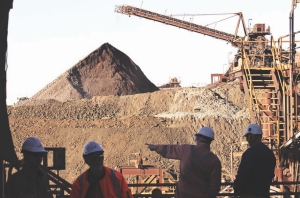PERTH, WESTERN AUSTRALIA–By the end of this year, BHP Billiton (BHP-N, BLT-L) will have completed a prefeasibility study for transforming the Olympic Dam copper-uranium-gold mine into a massive open-pit operation, with a definitive feasibility to follow in early 2010.
The company hasn’t been releasing a lot of information on the expansion, in part due to the corpo- rate manoeuvres taking place in mining’s biggest chess game: BHP’s takeover bid for rival giant Rio Tinto (RTP-N, RIO-L).
However, in a recent statement, BHP chief executive Marius Kloppers promised the market some enlightenment in September. He said the grand plan for Olympic Dam would be outlined before further movement on the Rio bid — seen by the market as costing about A$160 billion ($150 billion).
While big iron ore mines may involve moving mountains, the Olympic Dam blueprint is to create mountains in the virtually flat desert country of South Australia’s Far North. If it is not already Australia’s greatest mine, it will be, with a production target of 730,000 tonnes copper metal, 19,000 tonnes uranium and 800,000 oz. gold annually.
But to get there, the big hurdle is ballooning costs versus metal prices. The latest estimates put costs of the expansion in the A$6-13 billion ($5.7-12.6 billion) range, but new taxes are on the way from the federal Labor party, elected late last year.
While Prime Minister Kevin Rudd supported the end of his own party’s No New Mines uranium policy, he appears hell-bent on introducing a carbon trading tax — which AngloGold Ashanti (AU-N, AGG-A) CEO Mark Cutifani has said would add A$26 million ($24 million) to costs at Anglo’s Australian mines. And that’s just a thimble-drop compared with the taxes that could be imposed on Olympic Dam. BHP and Australia’s other two established uranium miners are fighting the tax, arguing that uranium does not contribute to global warming.
BHP has also floated the idea of exporting some of its expanded uranium production within upgraded copper material as a cheaper avenue for mineral processing expansion.
The most illuminating information on Olympic Dam was given at the Australasian Institute of Mining & Metallurgy’s uranium conference in Adelaide in June. There, BHP’s uranium customer sector group chief, Graeme Hunt, said mining of the open pit could start at 18 million tonnes of ore per year, during which time underground mining may be phased out.
BHP could raise pit production in stages to 70 million tonnes per year, and this would see the addition of a greenfields concentrator and modifications to the smelter.
Hunt said the pit could grow as large as 6 km long by 3 km wide.
What makes the conversion from underground to open-pit mining so costly is that there is up to 300 metres of sterile cover over the massive orebody (which reportedly has been drilled to 2.5 km depth).
Hunt said the resource stands at 7.86 billion dry tonnes grading 0.86% copper, 0.29 kg per tonne uranium oxide, 0.3 gram gold per tonne and 1.6 grams silver. This estimate includes more than 2.2 million tonnes of contained U3O8, or about 40% of the world’s known uranium resources.
The Olympic Dam expansion will include an international-class airport, as a part of the project’s fly-in, fly-out workforce may come from overseas.
The other two mines
Australia’s most durable uranium mine is Energy Resources of Australia’s (ERA-A), Ranger mine in the Northern Territory. ERA, 68.4% owned by Rio Tinto, has been able to expand Ranger’s resource picture –both through exploration and by lowering the cutoff grade as the price of uranium has increased over the past two years.
ERA declared an after-tax profit for the first half of the year of A$39.9 million. The company milled 1.05 million tonnes grading 0.26% uranium oxide at Ranger, producing 5.2 million lbs. U3O8.
ERA CEO Chris Salisbury said expansion studies have shown potential for extending the Pit 3 deposit to target 8,000 tonnes of contained uranium, and for a 10-million-tonne-per-year heapleach facility to recover 15,000-20,000 tonnes of contained uranium annually from low-grade in-situ and stockpiled material.
Australia’s third uranium producer, Heathgate Resources (an affiliate of U. S.-based General Atomics), has the now-maturing Beverley in-situ-leach (ISL) mine in South Australia’s northeast.
Heathgate subsidiary Quasar Resources has made what many observers believe is Australia’s best new uranium find at Four Mile, only a few kilometres from the Beverley plant.
The South Australia government has granted mining permits for Four Mile (owned 75% by Quasar and 25% by Alliance Resources) (AGS-A) and first-stage mining is expected to begin in early 2010. The project will be an ISL operation, though higher-grade zones may be mined by open-pit methods. –The author is a freelance journalist based in Perth, Western Australia.


Be the first to comment on "BHP Billiton grapples with Olympic Dam expansion"